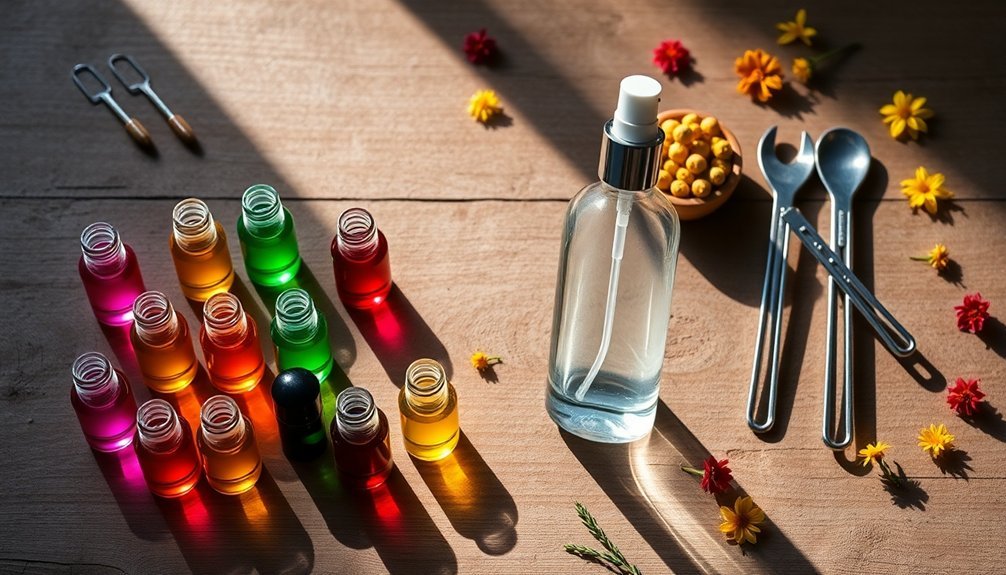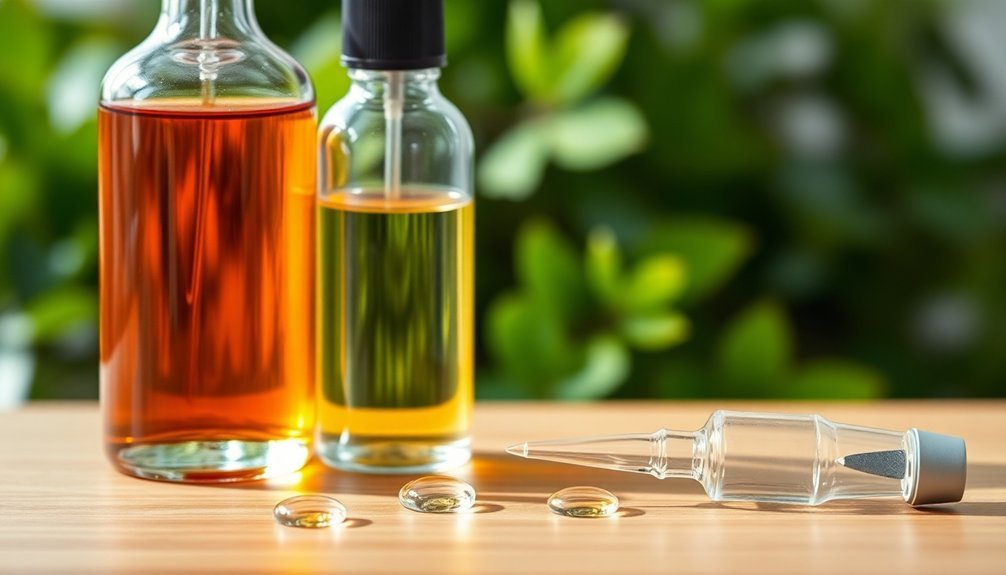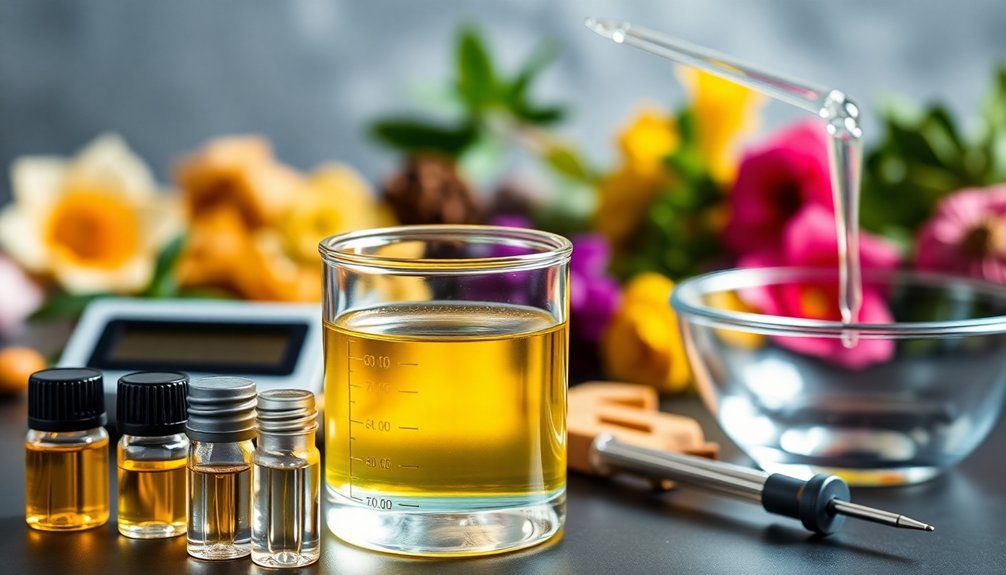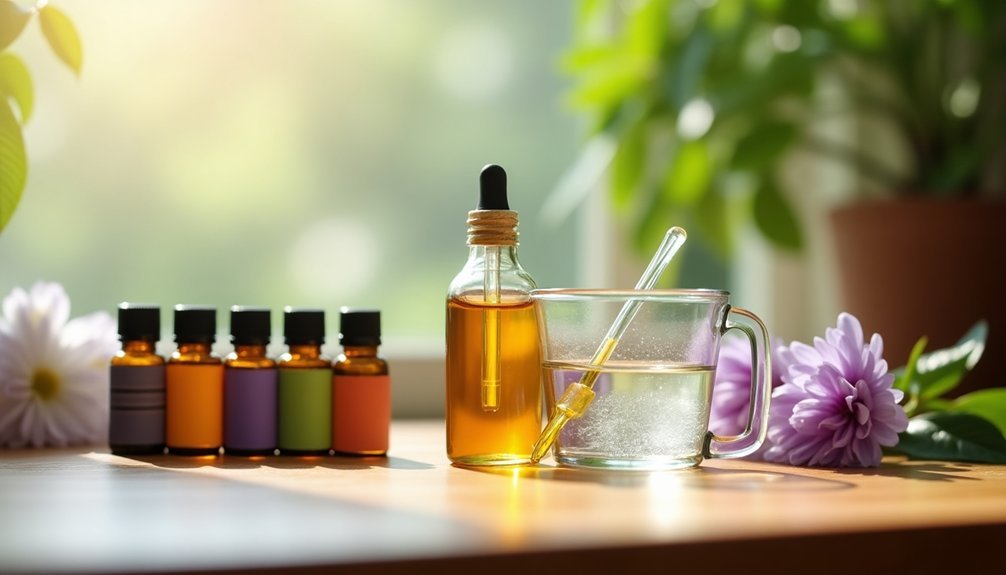To safely dilute fragrances, you'll need to follow specific concentration ratios: perfume extracts use 20-40%, eau de parfum 7-30%, and eau de toilette 6-20%. Start with essential tools like digital scales, pipettes, and proper storage containers. Always mix oils with carrier bases, not water, and stick to a 2-3% dilution for daily wear. For sensitive skin, begin with 1% concentration. There's much more to the art of proper fragrance dilution.
Understanding Fragrance Extract Concentrations

When exploring the world of fragrances, understanding perfume concentrations is essential to making informed choices.
Perfume extract, also known as "parfum" or "extrait de parfum," represents the most concentrated form available, containing 20-40% aromatic compounds mixed with 60-80% alcohol.
You'll find perfume extract delivers the most authentic expression of a fragrance, particularly emphasizing heart and base notes. While it's the most potent option, you might notice it's more intimate – only detected by you and those very close to you. Proper orchestration of fragrance is crucial for achieving the best tenacity and scent trail.
In comparison, lighter concentrations like eau de parfum (7-30%) and eau de toilette (6-20%) project more openly but don't last as long.
Keep in mind that concentrations can vary between brands since there aren't strict regulations governing fragrance formulations.
Essential Tools and Equipment for Dilution
You'll need precise measuring tools like digital scales and pipettes to create accurate fragrance dilutions that meet your desired concentrations.
Proper storage containers, including amber bottles and atomizers, along with safety equipment such as gloves and masks, protect both you and your materials during the dilution process.
Document your dilutions using a record-keeping system to track formulas and maintain consistency in your fragrance work.
To complete your dilution setup, gather essential blending tools like stirring rods, fragrance blotters, and funnels for mixing and testing your creations.
Precision Measuring Devices Required
Four essential precision measuring devices form the foundation of successful fragrance dilution: digital scales, measuring cylinders, pipettes, and glass beakers.
You'll need these tools to guarantee accuracy and consistency in your perfume creation process.
- Digital scales that measure to 0.01g will help you weigh small quantities of essential oils with precision.
- Measuring cylinders and droppers give you exact control over ingredient quantities and help recreate your favorite blends.
- Glass and disposable pipettes let you transfer oils drop by drop without waste.
- Clean glass beakers provide a contamination-free mixing environment.
These tools support proper dilution ratios and safety when working with both essential oils and carrier oils for DIY skincare products.
All these tools promote precise dilution ratios and professional results.
Storage and Safety Equipment
Proper storage and safety equipment serve as essential safeguards when working with fragrance materials. You'll need an organized system of bottles, racks, and labeled containers to store your dilutions, blends, and raw materials. Having designated slots prevents spills and helps you maintain order.
Don't compromise on safety gear – always wear protective gloves, safety glasses, and a mask when handling fragrances. A lab coat or apron will protect your clothing from stains and chemical exposure. Your workspace should be well-ventilated to prevent fume buildup.
Keep your materials sorted by type (solids, liquids, powders) in appropriate containers. Use sturdy shelving units for bulk storage, but be mindful of vapor escape.
Remember to label everything clearly – this prevents mix-ups and guarantees accurate dilution processes.
Blending and Application Tools
Building on a solid foundation of safety practices, successful fragrance dilution requires a specific set of tools and equipment.
You'll need precision instruments to guarantee accurate measurements and proper mixing of your ingredients.
Essential tools for fragrance dilution include:
- Digital scales and glass beakers for precise measurements of raw materials
- Pipettes and droppers for transferring small amounts of liquids
- Amber or cobalt blue bottles to protect your blends from light damage
- Glass stirring rods and metal spatulas for mixing ingredients thoroughly
- Fragrance blotters to evaluate your dilutions' odor profiles
You'll also want to keep a notebook handy to record your formulations and calculations.
For professional-level accuracy, consider investing in lab-quality equipment like precision balances and magnetic stirrers.
Don't forget to properly label all your containers to track different dilutions and blends.
Step-by-Step Dilution Calculations
Making accurate dilution calculations serves as the foundation for creating safe and effective fragrances.
You'll need to start by determining your total desired volume and identifying the target percentage for your final product. To calculate the concentrate amount, multiply your total volume by the desired percentage in decimal form. For example, if you're making 100ml at 20%, you'll need 20ml of concentrate.
Next, subtract your concentrate amount from the total volume to determine how much solvent you'll need.
Don't forget to convert your measurements consistently – whether using drops, grams, or milliliters. For potent materials, you'll want to use serial dilutions, making step-by-step calculations to achieve your target concentration safely.
Always double-check your math and consult dilution charts when working with essential oils.
Selecting the Right Carrier Base

With your dilution calculations in hand, the next step is choosing the right carrier base for your fragrance.
You'll want to select a carrier oil that complements your perfume while ensuring it's safe for skin application. Consider both the technical and practical aspects of each oil option.
- Jojoba oil mimics your skin's natural oils and offers excellent longevity.
- Sweet almond oil provides a lightweight, fast-absorbing base.
- Fractionated coconut oil works well for most skin types.
- Grapeseed oil offers a neutral scent that won't compete with your fragrance.
- Witch hazel can serve as a natural preservative when needed.
When selecting your carrier base, focus on skin compatibility, absorption rate, and shelf life.
Remember that the right carrier oil won't just dilute your fragrance – it'll enhance its performance and staying power on your skin.
Safe Dilution Ratios for Different Applications
You'll need different dilution levels when creating perfume extracts versus sprays, with extracts typically using a 10-20% fragrance concentration and sprays using less.
For safety reasons, you shouldn't exceed 25% essential oil concentration in any fragrance formulation, with 10% being a safer maximum for daily wear.
When working with essential oils, you must follow stricter dilution guidelines than with synthetic fragrances, particularly for skin contact where a 3% or lower dilution is recommended.
Perfume Extract vs. Spray
To guarantee safe and effective fragrance application, understanding the difference between perfume extracts and sprays is essential.
Perfume extracts contain the highest concentration of essential oils (15-30%) and require sparing application to pulse points. In contrast, spray formats like EDT and EDP offer more versatile application methods with lower concentrations.
- Perfume extracts last longer on your skin due to their concentrated formula and minimal dilution.
- EDPs give you a balanced option with 10-20% concentration, making them ideal for daily use.
- EDTs provide a lighter alternative at 5-10% concentration, perfect for frequent reapplication.
- Eau de Cologne offers a moderate 3-8% concentration for liberal application.
- Eau Fraiche gives you the lightest option at 1-3% concentration, ideal for rejuvenating spritzes.
Essential Oil Safety Limits
Safe dilution of essential oils requires precise measurements and careful attention to concentration ratios.
When you're creating a blend, start with a 1% dilution (1 drop per teaspoon of carrier oil) for facial products and sensitive skin applications. For general adult use, you'll want to stick to a 2% dilution, while a 3% dilution works well for targeted, short-term treatments.
Never exceed 3% dilution for regular topical use, as higher concentrations can trigger skin sensitization.
You'll need to adjust these ratios based on specific applications: 0.2-1.5% for facial products, 1.5-3% for massage oils, and 1-3% for bath products.
Remember that certain oils, like Cinnamon Bark, require much lower dilutions due to their potency.
Always mix with carrier oils, never water, and label your blends with ingredients and creation dates.
Testing and Adjusting Your Final Formula

Once your fragrance formula is complete, thorough testing becomes essential for guaranteeing its quality and performance.
You'll want to evaluate your creation using multiple methods to understand how it performs in different applications and environments.
- Test on smelling strips to assess the scent's development, comparing different concentrations and documenting how the fragrance evolves.
- Create a reed diffuser test to evaluate the fragrance's throw and how it interacts with various materials.
- Prepare room spray samples to check dispersion and longevity in different environments.
- Run GC-FID analysis if you need detailed compositional verification.
- Compare your formula across multiple application methods to guarantee consistent performance.
Consider adjusting concentrations based on your test results until you achieve the desired scent profile and performance characteristics.
Remember that each application method may require different dilution ratios for ideal results.
Frequently Asked Questions
How Does Medication Affect the Longevity of Perfume on My Skin?
Your medications can alter your skin's chemistry, affecting how fragrances interact and last. GLP-1 drugs change insulin levels and reduce skin oils, making perfumes evaporate faster unless you moisturize well beforehand.
Can I Use Diluted Essential Oils in My Humidifier or Diffuser?
Yes, you can use diluted essential oils in both devices. Be sure you're following proper dilution ratios (5-10 drops per 100ml water), using pure oils, and running them intermittently to prevent respiratory irritation.
Why Do Some Perfumes Smell Different on Different People?
Your unique body chemistry, skin type, and hormones interact with perfume molecules differently. When combined with your diet, sweat, and natural oils, they create a personalized scent that's distinctly yours.
Does Skin Ph Affect How Long Fragrance Will Last?
Yes, your skin's pH level directly affects fragrance longevity. When your skin maintains its natural acidic pH (4.5-5.5), fragrances adhere better and last longer. An unbalanced pH can make scents fade faster.
Can I Mix Different Carrier Oils to Enhance Fragrance Retention?
Yes, you can mix carrier oils for better fragrance retention. Try combining jojoba oil (great for holding scents) with fast-absorbing grapeseed oil. This combo will help your fragrance last longer on your skin.
In Summary
You're now equipped to safely dilute fragrance extracts into wearable concentrations. Remember to keep detailed records of your ratios, always perform patch tests, and make small test batches before scaling up. Don't rush the process – proper dilution guarantees both safety and scent integrity. Start with conservative ratios and adjust based on your results. With practice, you'll master the art of fragrance dilution.





Leave a Reply